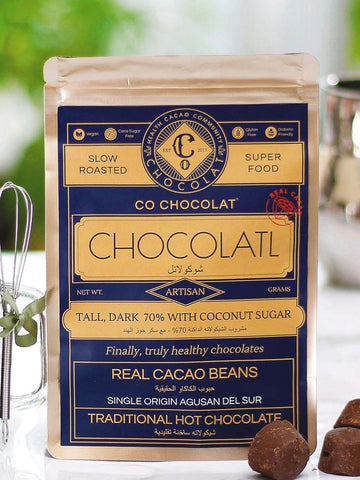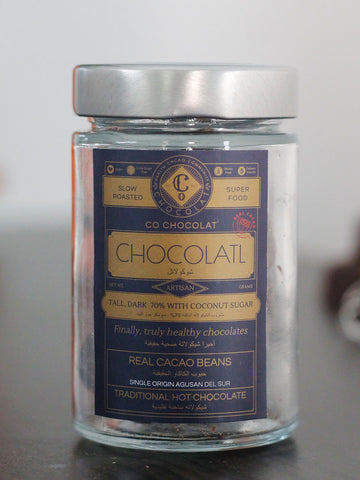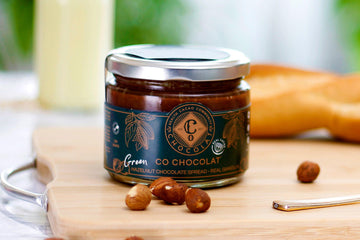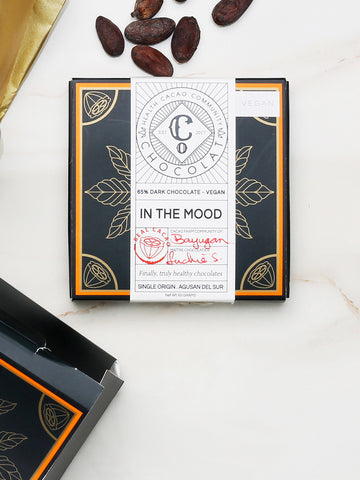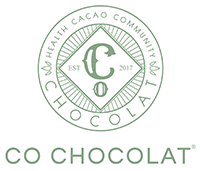FOOD WARS: GROUND CACAO VS. COCOA POWDER
Welcome to the first match of Food Wars - where two types of food are pitted against each other. But in the end, only one will emerge victorious and gain the title of:
“Truly Healthy Chocolate”
Let’s meet our warriors!
In this corner, we have 100% Ground Cacao

You will see here that cacao beans from the cacao nibs are ground until the texture of a grainy powder. The process stops here and the cacao butter is kept intact. In this, you get 100% of the roasted cacao’s benefits because everything is still intact. For us at Co Chocolat, we intentionally avoid saying and making our cacao RAW because as a farm-to-table chocolate-maker, we know the realities of how cacao beans are moved in the farms from the pods, to the fermentation boxes, to the solar dryer. Whoever says cacao can be eaten absolutely raw are also absolutely unaware of the harmful pathogens which are potentially brought by living creatures, including humans, when untreated properly from farm to table.
In the other corner, we have Cocoa Powder

From the illustration above, we see that when Ground Cacao is further processed, it becomes what is technically called “Cocoa Liquor”(sans the alcohol!). The chocolate maker then decides whether she/he will want this cocoa liquor to become CHOCOLATES (like couverture, chocolatl or bars) or Cocoa Powder. If it’s the latter, the cocoa liquor is heated and compressed to release the cocoa butter and separate it from the cocoa paste using a machine called cocoa butter press. This is a similar process to cold-pressing for olive oil. In cacao, this process produces two products:
-
Cocoa butter, which can be stored and added to other chocolate products or sold to pharmaceutical or cosmetic companies
-
Cocoa solids which are pressed into a cake and then finely ground to produce what we now call COCOA POWDER. The cocoa cakes can be then go to an additional process wherein it is treated with an alkali salt to increase pH value and neutralize the acidity (called Dutch Process). This deepens the cocoa powder's color and improved its suspension in liquids.
So, are you ready to rumble? Check out the comparison below and you be the judge who wins this food war!
|
GROUND CACAO |
COCOA POWDER |
|
LEVEL OF PROCESSING (the more minimal, the more natural the food = better) |
|
|
Minimally Processed |
Medium to Highly Processed |
|
USE |
|
|
1. Known health drink even without milk or other ingredients because of its long history of building stamina, improving mood, acts as superfood, and as an aphrodisiac. 2. When a flavorful superfood is required in food preparation, it is the choice of Vegans and health-buffs for cooking and baking. 3. It is used for cooking and baking when the need of a strong chocolatey flavor and moisture (without adding additional oil) is desired. |
1. Primarily to give flavor and color for cooking, baking and confections. Also a cheaper ingredient to give that chocolate flavor. Examples of which are chocolate powder drinks, chocolate base spread, chocolate ice cream, etc. 2. A cheaper ingredient to making candies or confections with chocolate flavor such as “Chocolate Compound” a candy which only has the cocoa powder, vegetable oil (palm oil), sugar, vanillin, stabilizers and other ingredients we’ve come to know as chocolates. |
|
NUTRITIONAL BENEFITS |
|
|
Contains antioxidants (flavonols) that neutralizes and removes free radicals in the bloodstream. |
Many cocoa powders in the market use the Dutch Method that uses potassium carbonate solution to neutralized pH Acidity. [5] In a publication made by the Journal of Agricultural and Food Chemistry, evidence from the literature indicates that natural cocoas are high in flavanols, but when the cocoa is processed with alkali, also known as Dutch processing or Dutching, the flavanols are substantially reduced. [6] |
|
High in fiber and minerals that helps in lowering cholesterol and an excellent source of magnesium, iron, copper, potassium, and zinc. [2] |
Little research has been done on the stability of vitamins and minerals of cocoa powder. But it is possible that some vitamins and minerals that undergo high temperature processing can decrease the nutritional value of the beans. [7] |
|
Promotes weight loss. Since Cacao has lots of fiber, it can make you feel fuller. |
Does not promote weight loss because it has little fiber content. |
|
Improves mood [3]. Studies have shown that its flavonols helps combat depression and it also promotes aphrodisiac effects. |
Contains caffeine, which may have negative effects such as insomnia on caffeine-sensitive individuals. [1] |
|
Improves skin [4] boosts skin by improving blood flow, skin density and hydration. |
Highly processed, contains artificial flavorings and dyes that may influence hyperactivity in children [9] and some can cause hypersensitivity reactions to individuals. |
And the winner is….
GROUND CACAO.
Without a doubt, this real cacao product is packed with nutritional value, promotes weight loss, offers various health benefits and a total superfood! It is for this reason that here at Co, we’ve chosen to produce ground cacao and have veered away from cocoa powder. Food should not just be tasty or chocolatey, but it should be healthy. Start adding ground cacao as a staple to your kitchen and create delicious, healthy, chocolatey dishes for your family, specially your children. Let them grow up knowing what real chocolates taste and let them get the nutrients they deserve from cacao. In the end the real winner will be your family. Time to move up your chocolate game from Okay to Super!
Sources:
- Rafael Franco, Ainhoa Oñatibia-Astibia,and Eva Martínez-Pinilla. Health Benefits of Methylxanthines in Cacao and Chocolate. S. National Library of Medicine. Nutrients. 2013 Oct; 5(10): 4159–4173. https://www.ncbi.nlm.nih.gov/pmc/articles/PMC3820066/
- Giovanni Scapagnini, et.al. Cocoa Bioactive Compunds: Significance and Potential for the Maintenance of Skin Health. https://www.ncbi.nlm.nih.gov/pmc/articles/PM
- Matthew P Pase, Andrew B Scholey, Andrew Pipingas, Marni Kras, Karen Nolidin, Amy Gibbs, Keith Wesnes, Con Stough. Cocoa polyphenols enhance positive mood states but not cognitive performance: a randomized, placebo-controlled trial. First Published January 29, 2013. http://journals.sagepub.com/doi/abs/10.1177/0269881112473791
- Jong-Eun Kim, et.al Oral Supplementation with Cocoa Extract Reduces UVB-Induced Wrinkles in Hairless Mouse Skin. Journal of Investigative Dermatology. May 2016 Volume 136, Issue 5, Pages 1012–1021. http://www.jidonline.org/article/S0022-202X(16)00457-7/abstract
- Godman, Heidi. Cocoa: A Sweet Treat for the Brain?. Harvard Medical School. Harvard Health Publishing. Updated October 29, 2015. https://www.health.harvard.edu/blog/cocoa-sweet-treat-brain-201502057676
- Miller KB1, Hurst WJ, Payne MJ, Stuart DA, Apgar J, Sweigart DS, Ou B. Impact of alkalization on the antioxidant and flavanol content of commercial cocoa powders. J Agric Food Chem.2008 Sep 24;56(18):8527-33. doi: 10.1021/jf801670p. Epub 2008 Aug 19. https://www.ncbi.nlm.nih.gov/pubmed/18710243
- Fabrice Tonfack Djikeng, et.al. Effect of traditional and oven roasting on the physicochemical properties of fermented cocoa beans. S. National Library of Medicine. Heliyon. 2018 Feb; 4(2): e00533.
Published online 2018 Mar 1. doi: 10.1016/j.heliyon.2018.e00533. https://www.ncbi.nlm.nih.gov/pmc/articles/PMC5852288/
- University of South Hampton. Major study indicates a link between hyperactivity in children and certain food additives. Published September 6, 2007. https://www.southampton.ac.uk/news/2007/09/hyperactivity-in-
children-and-food-additives.page
- David L. Katz, Kim Doughty, and Ather Ali. Cocoa and Chocolate in Human Health and Disease. S. National Library of Medicine. Antioxid Redox Signal. 2011 Nov 15; 15(10): 2779–2811.doi: 10.1089/ars.2010.3697. https://www.ncbi.nlm.nih.gov/pmc/articles/PMC4696435/
- Co Chocolat. How are Chocolates made from farm to bar?. May 07, 2018. https://cochocolat.com/blogs/news/how-are-chocolates-made-from-farm-to-bar
- S. Department of Agriculture. Food Composition Table. https://ndb.nal.usda.gov/ndb/nutrients/report?nutrient1=262&nutrient2=&nutrient3=&fg=&max=25&subset=0&offset=0&sort=c&totCount=5058&measureby=g
- Ecole Chocolat Lecture on discussion on Chocolate History and Processing
- Chocolate Alchemy discussion on cacao roasting http://chocolatealchemy.com/cocoa-bean-roasting/
